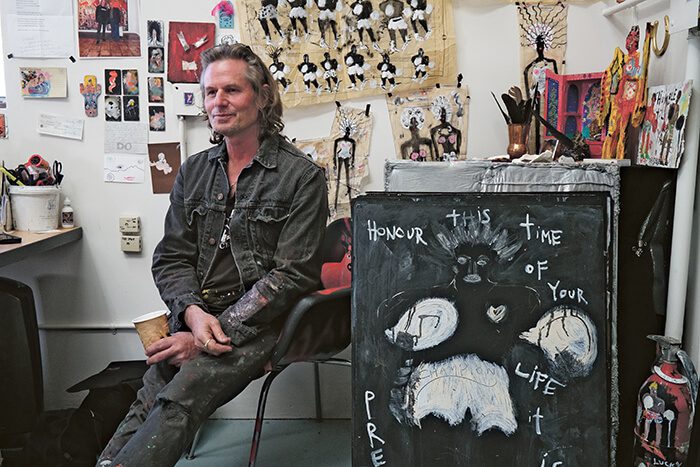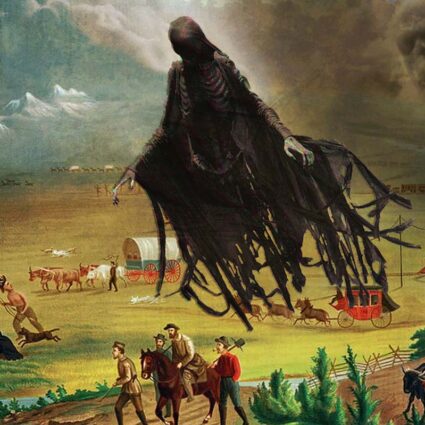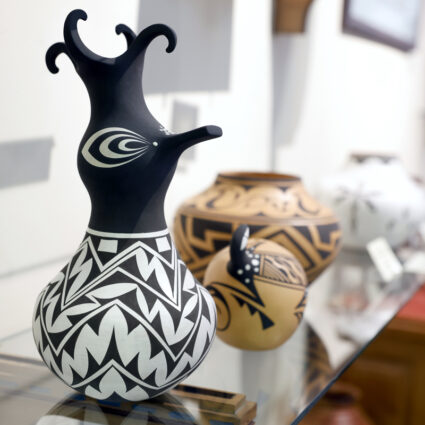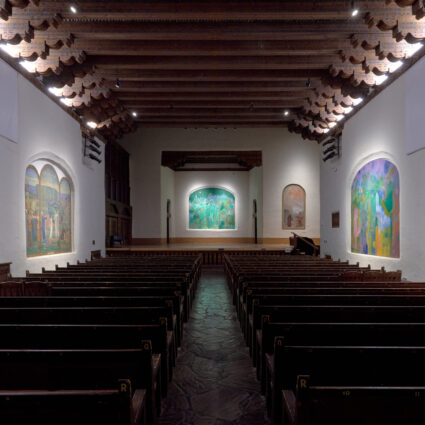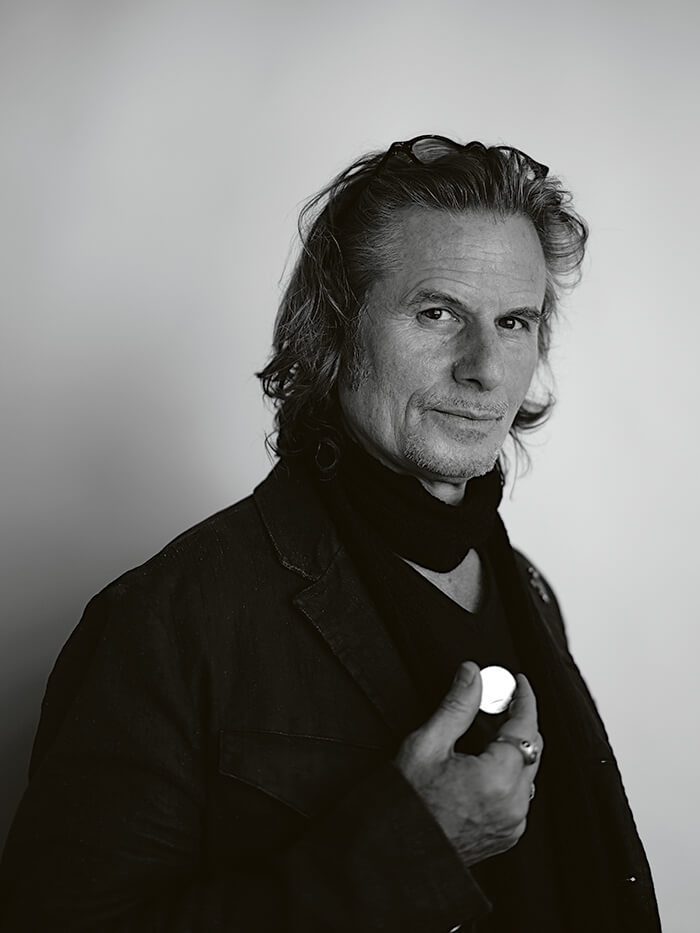
Richard Kurtz paints prolifically on almost any substrate he can find. Appropriating everything from children’s books to football helmets, vintage flash cards to large pieces of leftover plywood, Kurtz combines pictorial characters with hand-written aphorisms. His cadre of characters includes boxers, comic book heroes, and sexy ladies in corsets: all raw, mythic foils, and each presents a confrontation between boyish naiveté and world-weary wisdom, between fairy tale idealization and crude reality. We caught Kurtz in late 2016 on the cusp of a voyage overseas, and while he made no promises of his return, his work may still be seen in Santa Fe at Keep Contemporary and the recently relocated Jux.
Clayton Porter: How did you end up in this studio space?
Richard Kurtz: Here at the Second Street Studios, I’ve been here a little over a year. Before that, I was working at my kitchen table. I just had enough cash to be able to have a space. For an artist to have a studio space, I think it’s one of the most magnificent blessings one can have. I come here almost every day, from ten to six or seven, and I can be quiet, or relatively noisy, and I can play. It’s like having a play space. I feel really blessed.
CP: How long have you been working in Santa Fe?
The first time I came to New Mexico was around 1989 or 1990, I was living in the city and going to Mexico for the winter time, because I don’t like the cold. And for two or three years it was a good deal.
I had met someone who wanted to do a restaurant, so I did a restaurant in Santa Fe called Café Oasis. It opened the day after Christmas in 1993. My background, living in New Jersey and New York City, my dad knew a lot of Italians, and I loved the movies, so in my romantic view of the world, I just thought that you sat down, had a cappuccino, and that was how it would work out. Little did I know what a restaurant really takes. I did that for twelve years, and at the end of the day, how many friends do you have? I had maybe two friends. I’d house sit here, live in a car there, you know it was a pretty tough time. I was here for a couple years, and then I started to go to Miami. I’ve been back here about two and a half years.
I love to walk. I found these old targets while walking, these old NRA targets, and I started to draw and paint again, because I had done that when I lived in New York. I started this series [of boxers] in 2005-2006. I used to spar or train at a gym. When you’re in the ring you have to be really present. I couldn’t be thinking about anything else, I just had to be really present. And I love words, so I incorporated words with these targets, and it just came together, and I really enjoyed doing it.
CP: At one point you were actually boxing?
Training, yeah. I trained and sparred; I never had a professional fight. That would be the end of me! Once I was sparring with a guy that… have you ever gone body surfing, and gone underneath the water and couldn’t get up? This guy was hitting me like that with jabs, right on the ribs, so for a week or ten days it was hard for me to tie my shoes. So I kind of moved out of that. But I really enjoyed that, jumping, it’s really good aerobics.
When you’re in the ring you have to be really present. I couldn’t be thinking about anything else, I just had to be really present.
I started to paint the boxers when I was going through a really hard time. The works became like a daily mantra of whatever was going through me—if I heard something a friend said, or read something. And it was really a way to keep my focus.
At that time, I’d go to a coffee shop and they’d have all these plastic gift cards—I didn’t have canvas, it’s really expensive—so I’d do small little paintings on plastic credit cards or gift cards, so I did a series of those.
CP: From this little size to these middle sizes and large sizes, you can work in any size and they maintain the same energy.
I started doing those small pieces when I had very little. A friend of mine invited me down to Miami in 2006, and I really wanted to meet an artist named Purvis Young, whose work I really liked. So I made my way down and I met Purvis, and I had my portfolio and I showed it to his manager, he liked my work and said keep in touch.
Well, the next year he invited me to Miami and put me up during Art Basel. And that place was like an Old Italian New York social club, there would be cigars, smokers, coffee, people bullshitting and deals going down, you know, all different kinds of shenanigans, and I was standing around just listening. The guy goes, “I thought you were a painter, there’s paint back there and wood, just do some painting.” And I was like, really? So I went outside and I had seven or eight big panels of heavy plywood. I just painted, I just did it. I did maybe eight this large. A few sold, one went to Mexico City, one went to France. It takes a lot of energy to work large, for me. I love to do it, but you have to store it if it doesn’t sell… so I kind of got into doing smaller things, and I started doing books.
I started to paint these Little Golden Books. And I like doing the books, they’re kind of my favorite things to do. It is sort of like these different fairy tales that I’m making, or appropriating, or playing around with.
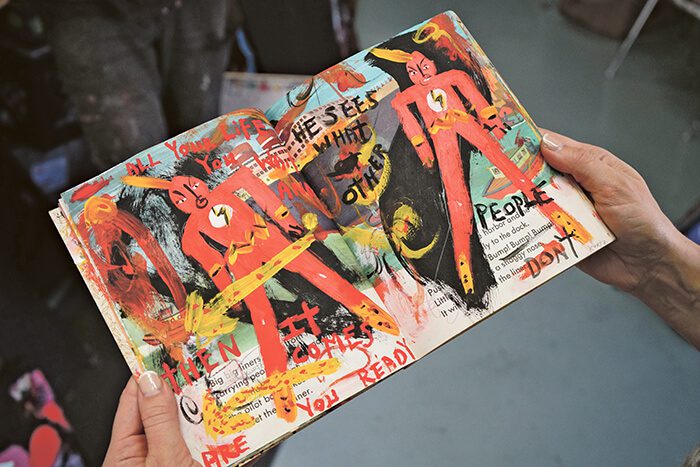
CP: Your content has gone from boxers, to these ladies, the Flash. What is your relationship to those characters?
Well, I like figures, and I like superheroes. So Flash was kind of a superhero. When I was in Miami, I went to the W Hotel and they have lots of book in their lobby, and there was one of those coffee table–sized books on the history of comics, and one evening I just read about the Green Lantern and Flash and the evolution of all these different characters in comics. I liked Flash, it was really easy for me to draw or paint, and I like being fast. Sometimes I move too fast. But I like the idea of Flash, alchemical infusion, maybe another planet. I’m into the multiverse—so I kind of related to the character.
And I like sexy women, you know, I feel like women are beautiful, and there are so many ways to be beautiful. I think when I was 10, 11, 12, or something, and I was playing around our house and I opened a drawer and my dad had some of those magazines from probably the ’50s of women and their garter belts, not totally nude, but just risqué. And it kind of stuck with me, I have those things that stick with me and they are just ways that I work out whatever is going on internally, so I think the women kind of came to me that way, too. It’s kind of how I go back to the mother, and the womb, and what kind of conditioning happened. And where am I now, and what kind of break through can I make to expand and evolve? And also, how can I grow as an artist in 2016? Where am I?
And maybe there are other characters and things for me to discover. Part of my excitement about leaving Santa Fe for a while and traveling to another country is that there is another perspective about who I am and the way I see things. I’m open to other opportunities and possibilities, other kinds of characters and discoveries. Take me to another realm, I’m ready.
Lauren Tresp: Do you ever feel stuck in your work?
Sometimes people say, “Oh, you just do boxers,” but the boxer is like some kind of foil, or something like an imaginary friend I can talk to every day.
When I get into creating the books, it takes me to a whole different place. I love the words, the words change and they become a daily interplay with what’s going on in my life or my own world. I don’t get stuck that way. The big thing is I just have to be light on my feet.
